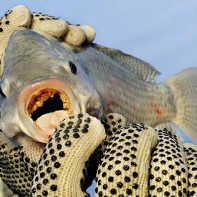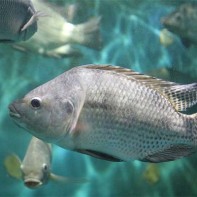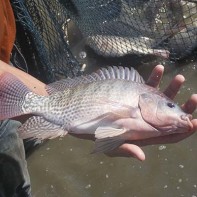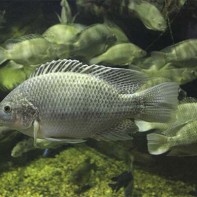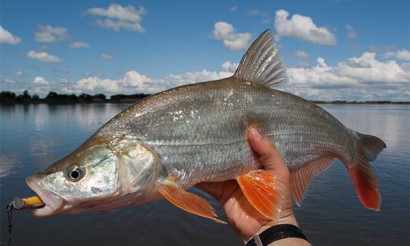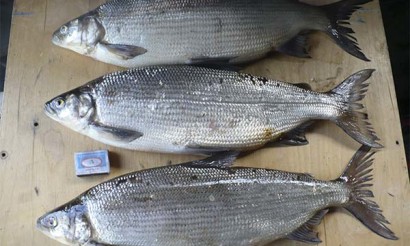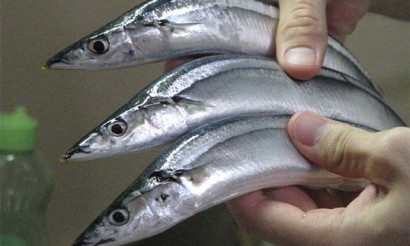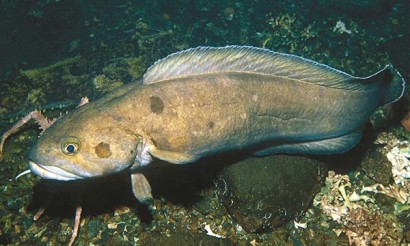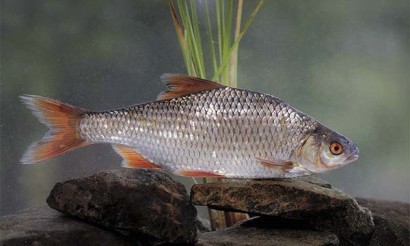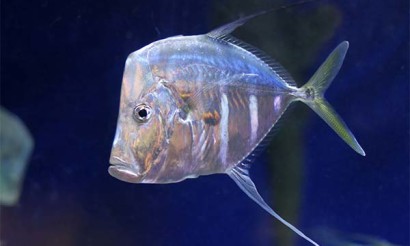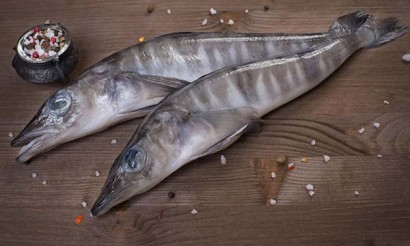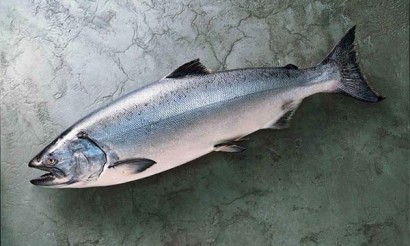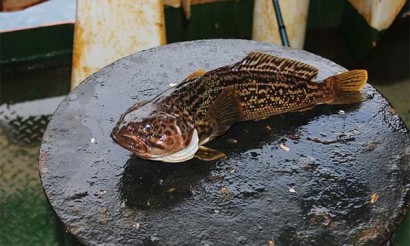Tilapia fish: description, useful properties, cooking recipes
Its scientific name (lat. Tilapia) the family of tilapia received its name only in the XIX century, although mankind has long been familiar with them. According to legends, the biblical five fish, which fed 5000 people, belonged to them. Sometimes tilapia are called St. Peter's fish. The first written mention of this member of the cichlid family dates back to ancient Egypt, where it was fished in the lower Nile.
- Tilapia: what kind of fish, how it looks and where it is found
- What it looks like
- Where does it live?
- What does it eat?
- Types
- Composition and calories
- What is tilapia meat good for?
- General benefits
- For women
- For Men
- In Pregnancy
- For breastfeeding
- For children
- The benefits of tilapia when losing weight
- Can I Eat Tilapia if I Have a Disease
- Diabetes mellitus
- Gastritis
- For pancreatitis
- For gout
- Hazards and contraindications
- How to choose and store the fish
- Tips for eating tilapia
- How to cook tilapia fillets: Recipes
- In the oven
- In the frying pan
- In a multicooker
- In the microwave
- In the steam cooker
- On the electric grill
- How to make tilapia fish cutlets
- Tilapia Soup: Recipe
- Q&A
- Tilapia and pangasius: the same thing?
- Tilapia: is it fatty or not?
- Are there many bones in the fish?
- Can I eat the skin?
- Why does tilapia smell like ammonia?
- How much is tilapia worth?
- Interesting Facts
Tilapia: what kind of fish, how it looks and where it is found
Tilapia is a very unusual fish. It is considered freshwater, but it can live and reproduce in salt water, which is why it is sometimes called a sea chicken. Although its homeland is the warm tropics, tilapia can exist at low temperatures of 10-15 ° C. Do not frighten this fish and the lack of oxygen in the water. Some varieties of Tilapia like aquarists, as members of this family easily develop sufficiently complex conditioned reflexes are able to recognize the host.
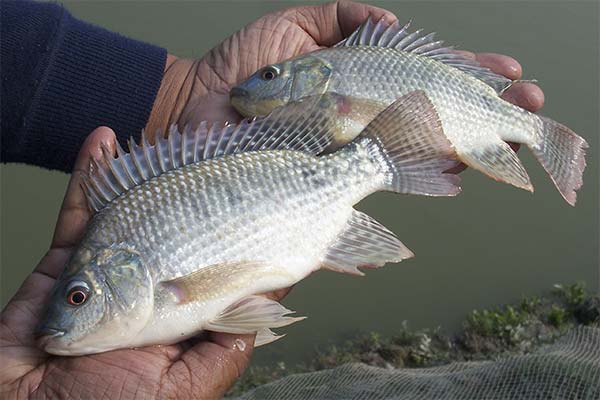
What it looks like
Tilapia with its flattened on the sides of the body resembles a flounder. It has large amber-gold eyes and a large mouth on its head. On average, it is about 35-50 cm long and 15-17 cm tall. Adult specimens usually weigh about two kilograms, but larger specimens can also be found. The large scales, tight to the skin, have a silvery hue. Some species have red or green spots.
Where Does It Occur?
Ichthyologists believe the tilapia is native to East Africa. The largest representative of this family, living in natural conditions, is found in the region of Lake Malawi. Many hundreds of years ago, the fish spread to the territory of Syria, Jordan and Israel. And in the 19th century, French expeditions brought it to Southeast Asia. In the former Soviet Union, it began to be cultivated in cooling ponds of industrial facilities, from where it entered natural water bodies.
Due to the unpretentiousness of this fish, farmers paid attention to it. Now it ranks second after carp in industrial farming. It is cultivated in Central and Southeast Asia, Africa, Latin America, the United States, and Europe. Tilapia export plays an important role in the Chinese economy.
What it eats
The benefits of breeding these fish are also due to their omnivorous nature. They like plant food: plankton, algae and other underwater plants. But if its lack is felt, it is easy to go to the food of animal origin. Tilapia does not refuse and from the bottom sediments.
Due to such indiscriminateness, this fish is sometimes called trash fish.
Types
There are about a hundred different species of tilapia. Most often the term is used as a common name for cichl fish belonging to the family Tilapia. But difficulties in classification cause the emergence of many hybrids, due to the ability of these representatives of the underwater kingdom to interspecific crossing.
Only four species or their hybrids are used in industrial production. The fastest growing of these is the Nile. Mosabic, red and blue are valued because of their high adaptation to low temperatures and marketable appearance.
Composition and calories
Tilapia is valued as a source of protein, which is also inexpensive and similar in taste to chicken meat. 100 grams of the product contains 20.1 grams of protein, 1.7 grams of fat. The nutritional value depends on the species and varies from 96 to 120 kcal.
The chemical composition of fish is impressive. In a hundred grams of edible part is:
Vitamins:
- B1 (thiamine) - 0.041 mg.
- B2 (riboflavin) - 0.063 mg.
- B3 (PP, nicotinic acid) - 3.903 mg.
- B4 (choline) - 42.5 mg.
- B5 (pantothenic acid) - 0.487 mg.
- B6 (pyridoxine) - 0.162 mg.
- B9 (folic acid) - 24 micrograms.
- B12 (cobalamin) - 1.58 micrograms.
- D (calciferol) - 3.1 micrograms.
- D3 (cholecalciferol) - 3.1 micrograms.
- E (alpha tocopherol) - 0.4 mg.
- K (phylloquinone) - 1.4 micrograms.
Macronutrients:
- Potassium (K) - 302 mg.
- Calcium (Ca) - 10 mg.
- Magnesium (Mg) - 27 mg.
- Sodium (Na) - 52 mg.
- Sulfur (S) - 200.8 mg.
- Phosphorus (P) - 170 mg.
Micronutrients:
- Iron (Fe) - 0.56 mg.
- Manganese (Mn) - 0,037 mg.
- Copper (Cu) - 75 mg.
- Selenium (Se) - 41,8 µg.
- Zinc (Zn) - 0.33 mg.
Essential Amino Acids:
- Arginine - 1.277 g.
- Valine - 0,97 gr.
- Histidine - 0,47 gr.
- Isoleucine - 0,93 gr.
- Leucine - 1,603 gr.
- Lysine - 1,81 gr.
- Methionine - 0,593 gr.
- Threonine - 0,95 gr.
- Tryptophan - 0,21 gr.
- Phenylalanine - 0,81 gr.
Substitutable amino acids:
- Alanine - 1.22 g.
- Aspartic acid - 2,297 gr.
- Glycine - 1,043 gr.
- Glutamic acid - 3,213 gr.
- Proline - 0,757 gr.
- Serine - 0,813 gr.
- Tyrosine - 0,68 gr.
- Cysteine - 0.22 g.
- Sterols (cholesterol) - 50 mg.
Saturated fatty acids:
- Myristic - 0.053 g.
- Palmitic - 0,424 gr.
- Stearic - 0,107 gr.
Monounsaturated fatty acids:
- Palmitic - 0.099 g.
- Oleic (omega-9) - 0,379 gr.
- Gadoleic (omega-9) - 0,02 gr.
Polyunsaturated fatty acids:
- Linoleic - 0.158 g.
- Linolenic - 0,033 gr.
- Omega-3 stioride - 0,003 gr.
- Eicosadienoic, Omega-6 - 0.003 gr.
- Eicosatrienoic - 0.01 gr.
- Arachidonic - 0,023 gr.
- Eicosapentaenoic acid (EPA) - 0.005 g.
A, also Omega-3 - 0.17 g. and Omega-6 - 0.194 g.
What is tilapia meat good for?
The benefits of eating tilapia meat are hard to overestimate.

General benefits
- Fish contains protein that is necessary for humans. It takes part in almost all the processes of the body, is necessary for the formation of muscle mass, is the building material for cells. One hundred grams of fish fillets contain about 22% of the daily requirement of protein for an adult.
- Selenium and antioxidants prevent the development of malignant tumors, fight free radicals and reduce the risk of oxidative stress.
- Fatty acids are beneficial to brain function. And selenium protects the brain from epilepsy, Alzheimer's and Parkinson's disease.
- Omega-3 normalizes blood pressure, prevents heart attack and stroke, reduces the risk of atherosclerosis.
- Including tilapia in your weekly diet promotes normal thyroid function.
For women
- In women, the meat of this fish reduces the risk of breast cancer. At high mental stress, it improves brain function, helps concentration, improves memory.
- Antioxidants along with tocopherol help the skin maintain a healthy and youthful appearance, improving its color and making it shiny.
- In stressful situations, the unique chemical composition of tilapia helps to restore the nervous system, normalizes sleep, improves psycho-emotional state.
For men
- Regular consumption of this fish helps to reduce the level of harmful cholesterol in the blood, eliminating the risk of cholesterol plaques.
- The mineral composition of the product has a beneficial effect on the genitourinary system and increases the potency.
- The high protein content is useful at high physical exertion, including sports. Phosphorus and potassium provide bone strength.
When pregnant.
Doctors recommend eating tilapia 2-3 times a week. Easily digestible protein helps in the formation of the fetus. Vitamins, micro-and macronutrients contained in the fish help the proper formation of the brain and nervous system, and maintain immunity of the future mother. Iron will prevent postpartum anemia.
When breastfeeding
During breastfeeding, the safety of the food that the mother eats for the baby comes first. Pediatricians advise to use tilapia during lactation, limiting herself to a small piece of about 50 grams a day two or three times a week. To avoid harm, the product should be bought only from trusted vendors, not hesitating to ask for a quality certificate.
The high protein content in its meat contributes to the rapid growth and development of the baby, helping the mother to recover after childbirth. Phosphorus contributes to the formation of a child's bone skeleton. Fatty acids contribute to the normal functioning of the nervous system.
Tilapia should not be introduced into the mother's diet before the baby is one month old. The first time eat a small piece of no more than 20 grams in the first half of the day and closely monitor the condition of the baby. If there were no problems with stool, on the skin no rash, the portion can be increased.
For children
Tilapia meat is very tender and has almost no small bones. Therefore, if the child is not allergic to fish, it can be included in children's menu from the eighth month of life, with prior consultation with the pediatrician. At first, you can give fish puree no more than one teaspoon per day to detect possible allergic reactions. Older children love cutlets made from this fish.
Tilapia is fully absorbed by the body and helps strengthen bones, improves brain function, memory, increases concentration, strengthens the immune system.
The benefits of tilapia for weight loss
Wishing to lose excess weight, most seek to increase protein foods and reduce carbohydrates in their menus. Tilapia in such a diet would be an ideal choice. In taste, the meat of this fish resembles chicken breast, so it is unlikely to cause rejection even among those who do not like underwater creatures.
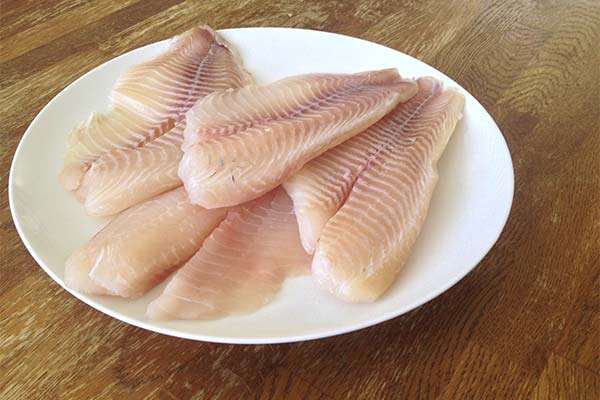
When selecting dishes, it is necessary to take into account that their caloric value directly depends on the cooking method. Therefore, it is worth refusing fried tilapia, giving preference to boiled or steamed. As a side dish, brown rice and fresh or stewed vegetables are excellent. In the evening you can eat a fish salad.
If a person starts to exercise intensively during the diet, eating tilapia will help maintain muscle tone.
Is it possible to eat tilapia if you are ill?
Tilapia has very few contraindications. But, in any case, those who suffer from chronic ailments, it is worth adhering to two rules:
- Before introducing this fish into the diet, you should consult with your doctor.
- Do not include tilapia in your daily menu. A dish of sea chicken is enough to eat twice a week.
In case of diabetes.
Without fish products, the menu of people suffering from diabetes is considered incomplete. But it is necessary to choose only those species where the fat content is minimal. Therefore, tilapia can be an indispensable product. Its protein is rich in vitamins and micro- and macroelements. They improve metabolism and promote cell renewal. Doctors recommend this fish for the prevention of cardiovascular diseases.
The taste, reminiscent of chicken meat, will help to nicely diversify your usual diet.
Important: The glycemic index of tilapia is 0 units.
For gastritis
With such a disease as gastritis, it is important that there is not a big break between meals. Therefore, lean fish becomes indispensable in the diet. It is well digested and does not cause irritation of the gastrointestinal tract and helps to restore the gastric mucosa. Especially, it will be useful for those who have an increased secretory function.
But we must not forget that only properly cooked tilapia can bring benefits. During an exacerbation of the disease, stewed or steamed dishes are recommended. You can bake the fillet in foil or in a sleeve.
In pancreatitis
The diet for pancreatitis requires careful thought. Choose only those dishes that do not irritate the pancreas. The benefits of tilapia in this disease are undeniable. It helps to:
- Normalize metabolism.
- Decrease the level of bad cholesterol in the blood.
- Contains in its composition fat-soluble vitamins.
Do not forget that you can eat fish not earlier than a week after the end of the acute attack. During this period, only steamed dishes are allowed. After another 7 days, you can include baked tilapia in your diet.
Even in prolonged remission, doctors do not recommend eating fish more than once a week. At the same time it can be combined with cereals.
In case of gout
The task of a diet with gout is to stabilize the work of the patient's body, normalize the purine metabolism and reduce the level of urate in the blood. Many seafood and fatty varieties of fish are not available. Tilapia is a rare exception, but only if it is caught in the wild in ecologically clean waters. This is due to the fact that on farms that raise this breed of fish on an industrial scale, it is often barked with soy or corn products.
But even with complete confidence in the high quality of the product, it should not be abused. Cooked twice a month with the least amount of fat, tilapia can help diversify the diet.
Harms and contraindications
Despite the undeniable benefits, you should consider that in some cases it is contraindicated to eat tilapia. Such cases include:
- Individual intolerance.
- Bronchial asthma.
- Diseases of the joints.
- Allergic predisposition to fish and seafood.
Due to the fact that tilapia are omnivores, some unscrupulous farmers add hormones, antibiotics to the food. Therefore, buying fish from hands or unverified manufacturers, there is a risk of serious harm to your own health.
Tilapia, caught in the wild, could eat different wastes, chemicals. Therefore, you can cook with it only if there is confidence that it was caught in an environmentally friendly area.
How to choose and store fish
When choosing tilapia, you should pay attention to its appearance:
- The uncut fish should have undamaged scales of a pale silver hue and long fins.
- The carcass should smell fresh from the river. If it smells of chemicals or medication, or the aroma is too pungent, you should refuse to buy. Most likely, the fish has been fed illegal substances.
- Frozen fillets should be a pale pink color by standards.
- Chilled fish has clear and shiny eyes.
It is better to put frozen fish immediately in the freezer. The cooled carcass can be kept in the refrigerator for no more than three days. But if the fish has defrosted, you should cook it. Do not put it back in the freezer.
Recommendations for eating tilapia
Despite the many myths about the harm of this fish due to its omnivorousness, everything is not so terrible. Most of them come from ignorance of the biological processes.
Almost all toxic substances in fish are concentrated in its liver, which is designed by nature itself to play a protective role. Therefore, a whole carcass should be thoroughly gutted, cleaned and washed under running water. But it is enough to put it frozen for 24 hours in the refrigerator, and then you can proceed to cooking.
How to cook tilapia fillets: recipes
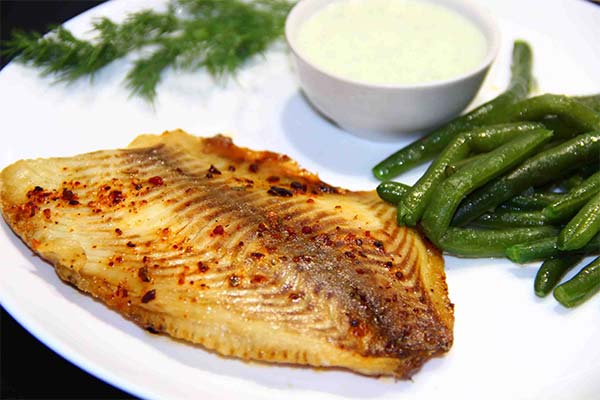
In the oven
Fillet of tilapia baked in foil
Ingredients: 4 thawed fillets, 1 lemon, 4 tablespoons mayonnaise, horseradish, garlic, herbs, salt, pepper.
Step by step recipe: Cover a baking tray with foil and put the fish fillet, sprinkle it with salt, pepper, finely chopped garlic. Wrap everything carefully. Heat up the oven to 200 ° C and bake for about 20-25 minutes. To prepare the sauce, peel the lemon and grind the zest with a blender. In the mayonnaise add horseradish, finely chopped greens and a teaspoon of chopped lemon zest. Everything is mixed. Before serving, the cooked fish is sprinkled with lemon juice. The sauce is served separately.
Tilapia with tomatoes
Ingredients: 400 grams of fish fillets, 1 kilogram of tomatoes, 40 ml of lemon juice, 80 grams of hard cheese, vegetable oil, salt, fish seasoning.
Step by step recipe: Cut the fillet into strips, sprinkle with lemon juice, salt and sprinkle with spices. Cut the tomatoes in half and carefully take out the flesh so as not to damage the skin. Roll up the tilapia strips and put them in the free halves of the tomatoes. Put the future snack in a baking dish, greasing it with butter. Sprinkle everything with grated cheese and bake at 200 ° C for about 25 minutes. The dish is most often used for a buffet or holiday table.
In the pan
Fried fish fillet in batter
Ingredients: 4 thawed tilapia fillets, 150 grams of flour, 1 egg, 1 tablespoon of vegetable oil, salt, pepper, herbs.
Step by step recipe: beat egg with fork or blender. In a wide container, mix flour with salt and pepper. Dip cut into portions of the fillet into the egg, and then roll in flour. Fry the fish in glowing oil on each side for 8-10 minutes until golden brown. Serve with stewed vegetables or rice.
Tilapia fried with vegetables
Ingredients: 3 tilapia fillets, 2 bell peppers, 2 onion heads, lime, 400 ml coconut milk, 2 tbsp vegetable oil, curry, sugar, herbs, salt.
Step by step recipe: divide the fillets into portions, cut the peppers into strips, onions into half rings. Squeeze the juice from the lime into a separate container. Fry onion and pepper on high heat, add curry and herbs, pour milk and salt everything. Turn the heat down to low and simmer for about 5 minutes. Add the fish and simmer for a few minutes, then flip the fillets over. When the tilapia is ready, pour in the lime juice. Serve with side dishes.
In a multicooker
Spicy tilapia
Ingredients: 600 grams of fish fillets, 2 medium onion heads, 1 carrot, 300 ml of cream, 100 grams of any hard cheese, 2 tbsp of lemon juice, salt, spices, vegetable oil.
Step by step recipe: Cut tilapia fillets into portions. Peel and grate carrots. Onion chop finely. In a multicooker pour vegetable oil and fry the vegetables in the mode "frying" until golden. Add the fish in a bowl, 200 ml of cream, salt and spices to taste. Stir everything and turn on the "baking" mode for 30 minutes. After the signal for the end of cooking, put the remaining cream and grated cheese in the multicooker. Place in the same mode for another 15 minutes. Serve the dish with fresh vegetables or rice.
In the microwave
Fish and zucchini
Ingredients: 600 grams of tilapia fillets, 1 medium-sized zucchini, 3 tomatoes, 50 grams of melted cheese, 2 tablespoons of lemon juice, 1 tablespoon of classic soy sauce, herbs, salt, ground pepper.
Step-by-step recipe: cut tilapia into pieces, drizzle with lemon juice, sprinkle with salt and pepper. Zucchini and tomatoes cut into circles. Put fish, zucchini and tomatoes in layers in a baking dish and pour soy sauce over them. Cover the dish with a lid and put it in a microwave for 5 minutes at 800W power. Take out the container, sprinkle the dish with greens, put the cheese slices on top and put it to cook in the microwave for another 5 minutes. You can serve it as a dish on its own.
In the steamer
Steamed diet tilapia
Ingredients: 400 grams of thawed fish fillets, 1 lemon, 250 ml of water, dry fish seasoning.
Step by step recipe: mix salt and spices in a bowl and roll the pieces of tilapia in it. Preheat the steamer and place the fillets in it. Cut the lemon into thin slices and place them on the fish. Cooking time is about 17-20 minutes, then leave to stand for another five minutes. Serve at the table with vegetable side dish.
On the electric grill
Mexican appetizer of tilapia with mushrooms
Ingredients: 2 pieces of cooked tortillas tortillas, 2 tilapia fillets, 150 grams of any hard cheese, half a head of onion, ½ red bell bell pepper, 300 grams of fresh or frozen mushrooms, 3 tablespoons of classic soy sauce, 1 tablespoon of corn oil, salt.
Step-by-step recipe: defrost fillets and mushrooms, if frozen, in advance. Heat oil in a frying pan and fry chopped mushrooms for about 5 minutes over medium heat. Peel the peppers and cut them into julienne strips. Add to the mushrooms, pour the soy sauce over them, add about 0.5 teaspoons of salt, stir and cook for another 5 minutes. Salt tilapia fillets on both sides and grill on the electric grill on high and low for 5 minutes. Arrange the tortillas on a board and place about half of the grated cheese in the middle of each tortilla. Add the mushrooms and the grilled filet and sprinkle with the remaining cheese. Wrap the tortillas on both sides and flatten the edges to keep them from unrolling. Grill the Mexican hot sandwich until the crusty streaks appear from the grill. The quesadilla is ready. Can be cut into several pieces before serving.
How to make tilapia fish cutlets

Fish cutlets recipe with rice
Ingredients: 1/3 cup of rice, 700 grams of fish fillets, 1 chicken egg, 2 slices of loaf, salt, ground pepper, herbs, breadcrumbs.
Step by step recipe: Wash rice, boil in salted water and let cool. Pass thawed tilapia fillet through a meat grinder. Add egg, salt and pepper to taste. Soak the bread in warm water or milk for a few minutes, then squeeze the water and mix the pulp with the stuffing. In the resulting mass add finely chopped greens and boiled rice. Mix until a homogeneous mass is obtained. Form cutlets in breadcrumbs and fry in vegetable oil until golden brown.
Tilapia Soup: Recipe
Ingredients: 5 pieces of fish fillets, 6 medium potato tubers, 2 medium carrots, 2 heads of onions, 1 bell pepper, 2 tablespoons of ketchup, vegetable oil, black pepper, bay leaf, salt.
Step by step recipe: Cut the tilapia fillet into small pieces and put it into boiling salted water. While it boils, finely chop onion and carrot and fry them on medium heat. Wash and peel potatoes and bell peppers and dice them. Let the fish simmer for 10 minutes, then put the potatoes in the pot. After another 5 minutes add sweet pepper, peas and bay leaf. After 10 minutes you can put the roast and ketchup. After 10 minutes turn off the gas, cover the pot and let it stew for a while. Before serving, put chopped greens on the plate.
Question-answer
Tilapia and pangasius: one and the same?
These fish belong to different families. Pangasius belongs to the catfish family, and tilapia belongs to the cichlid family. Even externally, they cannot be confused. Large, dark gray in color with a silvery belly, pangasius is sometimes called a shark catfish, because of the external resemblance to this formidable predator. An adult specimen grows up to 1.5 meters and weighs more than 40 kilograms. Tilapia looks tiny in comparison.
These fish are confused because of their meat, which is delicate in taste. If necessary, they can be substituted with each other in the recipe without fear of spoiling the taste of the dish.
Tilapia: fatty fish or not?
This member of the cichlid family is a low-fat fish. In 100 grams of the product there is only 1.7 grams of fat.
Are there many bones in the fish?
Tilapia refers to little bony fish. If the fillet is separated from them competently, its weight is about 35-40% of the total weight of the carcass, while, for example, cod has only 20-25%.
Can I eat the skin?
There is no scientific evidence that the fish skin contains a lot of harmful substances. So eating it or not is a matter of taste for each person.
Why does tilapia smell like ammonia?
Quality fresh tilapia should not smell of ammonia. It has its own slight specific flavor, which can easily be eliminated by adding a little lemon juice when cooking.
If even a slight odor, unnatural for this kind of fish, is felt, then it should not be eaten and fed to pets.
How much does tilapia cost?
Fish fillets can be bought at a price of 400-550 rubles per kilogram.
Interesting Facts
- Tilapia, unlike its brethren, often creates family pairs that live together throughout their lives.
- When an aggressive invader appears, these small fish are able to unite in a flock to drive the outsider out of their territory.
- The tilapia nurture their future offspring in its mouth, thus keeping it safe from enemies. Hatching fry, in case of danger, hide there as well. So the parent is forced to live with its mouth open for some time.
- Few people know that tilapia, if necessary, can change their sex. Most often females become males.
«Important: all information on this site is for informational purposes only. for informational purposes only. Before applying any recommendations, consult a tilapia specialist. specialist. Neither the editors nor the authors shall be liable for any possible harm caused by materials."


